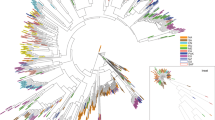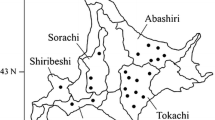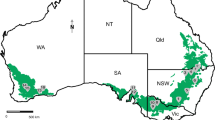Abstract
The population structure and genotypic diversity of Mycosphaerella graminicola from six natural field populations in Germany were studied with molecular markers. To reveal the potential effects of plant host resistance on the pathogen population, hierarchical samples were taken from susceptible and resistant cultivars. A total of 203 single spore isolates was subjected to molecular marker analysis using the amplified fragment length polymorphism technique (AFLP). Among the 203 isolates analyzed, 142 different multilocus haplotypes (MLH) were identified revealing a high degree of genotypic diversity of the M. graminicola population. On average, a F ST value of 0.04 was found, indicating a low genetic differentiation with only 4% of the genetic variation between the local populations but leaving 96% of the genetic variation within the populations. According to the low F ST value, a high migration rate of Nm ≈ 12 was found. The observed high within-population diversity, and the significant migration between populations, prevented genetic isolation and differentiation of putative geographically separated populations. Furthermore, plant host resistance had no obvious effect on the population structure and diversity of M. graminicola. Genotypic variability can be attributed to sexual recombination which appears to have a considerably larger influence on the population structure. Gene flow on this scale could have significant implications for plant breeding and fungicide spraying programmes.
Similar content being viewed by others
References
Ballantyne B and Thomson F (1995) Pathogenic variation in Australian isolates of Mycosphaerella graminicola.Australian Journal of Agricultural Research46:921-934
Boeger JM, Chen RS and McDonald BA (1993) Gene flow between geographic populations of Mycosphaerella graminicola (anamorph Septoria tritici) detected with restriction fragment length polymorphism markers.Phytopathology 83:1148-1154
Brokenshire T (1975a) The role of graminaceous species in the epidemiology of Septoria tritici on wheat.Plant Pathology24: 33-38
Brokenshire T (1975b) Wheat seed infection by Septoria tritici. Transaction British Mycological Society64:331-335
Brown JKM (1996) The choice of molecular marker methods for population genetic studies of plant pathogens.New Phytologist 133:183-195
Chen RS and McDonald BA (1996) Sexual reproduction plays a major role in the genetic structure of populations of the fungus Mycosphaerella graminicola.Genetics142:1119-1127
Eyal A (1999) Breeding for disease resistance to septoria and stagonospora diseases of wheat. In:Lucas JA, Bowyer P and Anderson HM (eds) Septoria on cereals (pp 332-334) CAB International, Wallingford, UK
Klink H (1997) Geoepidemiologische Erhebungen von Weizenpathogenen in Schleswig-Holstein unter Anwendung und Entwicklung des intergrierten Pflanzenschutzsystems (IPSModellWeizen) für einen minimierten, bedarfsgerechten Fungizideinsatz. PhD Thesis, Inst of Phytopathology, University of Kiel
Majer D, Mithen R, Lewis BG, Vos P and Oliver RP (1996) The use ofAFLPfingerprinting for the detection of genetic variation in fungi.Mycological Research100(9):1107-1111
McDermott JM and McDonald BA (1993) Gene flow in plant pathosystems.Annual Reviews Phytopathology31:353-373
McDonald BA and Martinez JP (1990) DNA restriction fragment length polymorphisms among Mycosphaerella graminicola (anamorph Septoria tritici) isolates collected from a single wheat field.Phytopathology80:1368-1373
McDonald BA and McDermott JM (1993) Population genetics of plant pathogenic fungi.BioScience43(5):311-319
McDonald BA, Pettway RE, Chen RS, Boeger JM and Martinez JP (1995) The population genetics of Septoria tritici (teleomorph Mycosphaerella graminicola).Canadian Journal of Botany73(Suppl.): 292-301
McDonald BA, Mundt CM and Chen RS (1996) The role of selection on the genetic structure of pathogen populations: Evidence from field experiments with Mycosphaerella graminicola on wheat.Euphytica92:73-80
McDonald BA, Zahn J, Jarden O, Hogan K, Garton J and Pettway RE (1999) The population genetics of Mycopshaerella graminicola and Phaeosphaeria nodorum. In: Lucas JA, Bowyer P and Anderson HM (eds) Septoria on cereals (pp 44-69) CAB International, Wallingford, UK
Nei M (1972) Genetic distance between populations.American Nature 106: 283-292
Nei M 1978. Estimation of average heterozygosity and genetic distance from a small number of individuals.Genetics 89:583-590
Schnieder F, Koch G, Jung C and Verreet JA (1998) The application of molecular markers for genetic characterization of Septoria tritici populations.Journal of Plant Disease and Protection105:452-461
Shaw MW (1987) Assessment of upward movement of rain splash using a fluorescent tracer method and its application to the epidemiology of cereal pathogens.Plant Pathology 36:201-213
Shaw MW and Royle DJ (1989) Airborne inoculum as a major source of Septoria tritici (Mycosphaerella graminicola) infections in winter wheat crops in the UK.Plant Pathology 38:35-43
Slatkin M and Barton NH (1989) A comparison of three indirect methods of estimating average levels of gene flow.Evolution 43:1349-1367
Somasco OA, Qualset CO and Gilchrist DG (1996) Single-gene resistance to Septoria tritici blotch in the spring wheat cultivar 'Tadinia'.Plant-Breeding115:261-267
Verreet JA (1995) Principles of integrated pest management - The IPM wheat model.Pflanzenschutznachrichten BAYER 48 Germany
Vos P, Hogers R, Rijans M, Van de Lee T, Horens M, Fijters A, Pot J, Peleman J, Kuiper M and Zabeau M(1995) AFLP: a new technique for DNA fingerprinting.Nucleic Acids Research23: 4407-4414
Weir BS and Cockerham CC(1984) Estimating F-statistics for the analysis of population structure.Evolution 38(6): 1358-1370
Wilson RE (1985) Inheritance of resistance to Septoria tritici in wheat. In: Scharen AL (ed.) Septoria in Cereals,Proceedings of Workshop, Montana State University, Bozeman, Montana, USA, 1983: 33-35
Wright S (1951) The genetical structure of populations.Ann Eug. 15:323-354
Zadoks JC, Chang TT and Konzak CF (1974) A decimal code for the growth stage of cereal.Weed Research14:415-421
Author information
Authors and Affiliations
Rights and permissions
About this article
Cite this article
Schnieder, F., Koch, G., Jung, C. et al. Genotypic Diversity of the Wheat Leaf Blotch Pathogen Mycosphaerella Graminicola (anamorph) Septoria Tritici in Germany. European Journal of Plant Pathology 107, 285–290 (2001). https://doi.org/10.1023/A:1011256504146
Issue Date:
DOI: https://doi.org/10.1023/A:1011256504146




